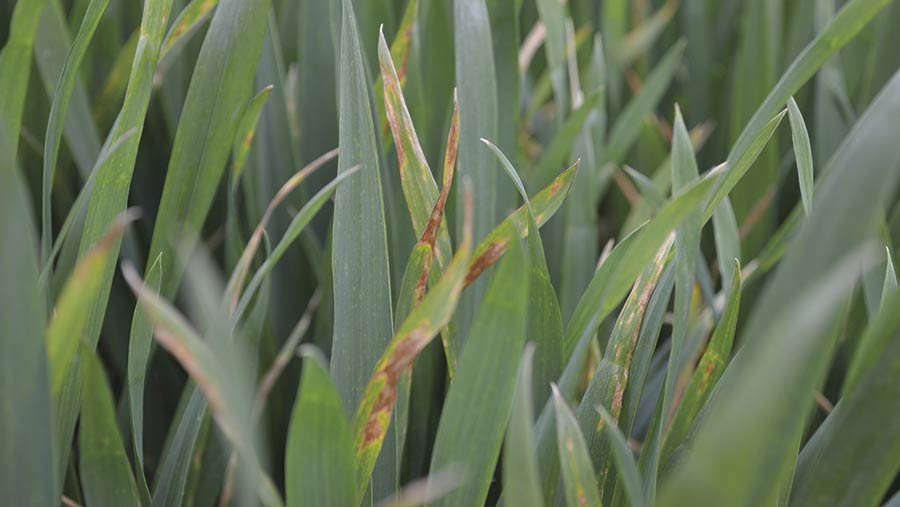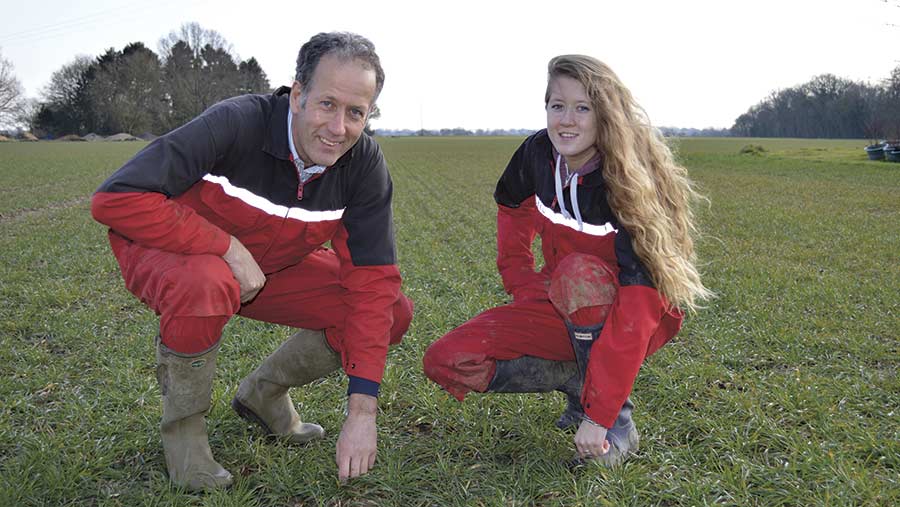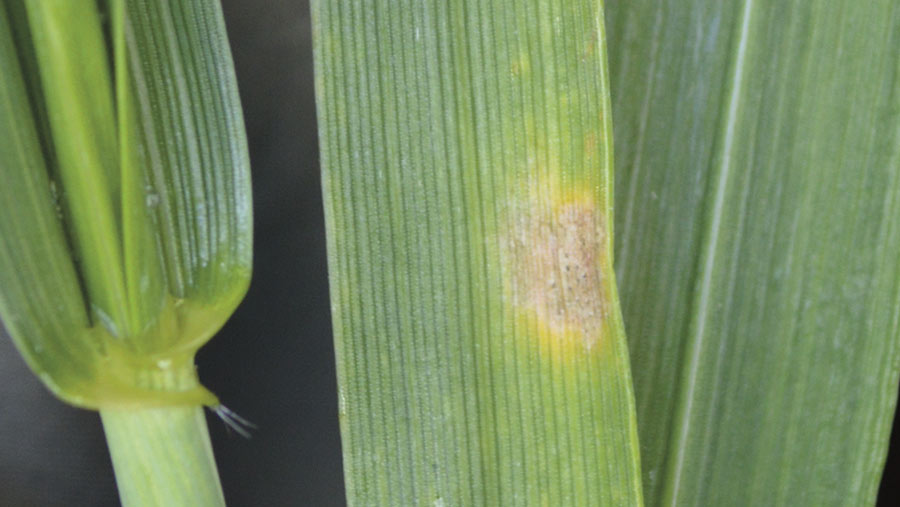How the two new wheat fungicides perform on farm

Two East Anglian wheat growers checked out one of the big new fungicide launches last season to see if it would give good control of disease and lift yields.
The new product is aimed at the important flag leaf T2 timing and contains two SDHI fungicides along with an azole, and gave a yield improvement despite a generally low disease year.
David Jones travelled to meet the two farmers in Suffolk and Essex to see how the new fungicide performed on their farms.
See also: Wheat growers should be cautious over early fungicide sprays
Robert Dyball – Suffolk
Suffolk grower Robert Dyball was eager to try the two new SDHI fungicides launched last year on his wheat and found one lifted his yields and saved him a late season spray.
He grows wheat varieties with good disease resistance but wanted to see which SDHI would give him the best control of his number one disease worry – septoria.

Robert Dyball and daughter Dominique
A dry early spring in 2017 saw his winter wheat crops wilting, but they were relatively free of disease until heavy rain in mid-May put them at risk from the wet-loving septoria.
He looked to try out new additions to the 2017 fungicide market – namely SDHI-azole fungicide products Ascra and Elatus – set against his farm standard practice of Librax at the key flag leaf T2 fungicide timing in late May.
“The season had been a fairly low-risk disease one, but we were looking for a product to protect the top three leaves,” he tells Farmers Weekly.
Actives
- Ascra – two SDHIs bixafen and fluopyram plus azole prothioconazole
- Elatus – SDHI benzovindiflupyr (solatenol) plus azole prothioconazole.
- Librax – SDHI fluapyroxad plus azole metconazole
Yield advantage
He tried both new products on a field of the feed wheat variety Graham at the T2 timing, and the Ascra gave him a 0.42t/ha yield advantage, which worked out at £57/ha at a feed wheat price of £135/t.
His on-farm trial was conducted on a 8ha block, split down the middle with one half treated with Ascra and the other Elatus.
Both gave good enough control of disease that he did not have to use a T3 head spray later.
He was surprised at the yield difference as there was no visible difference between the two trial blocks, and it was difficult to tell the dividing line.
Both fungicides were used at their maximum dose levels to give robust control with the addition of the protectant fungicide chlorothalonil. Both treatments cost about £50/ha.
Missing out a spray
“It was not the worst season for septoria but we were looking to stretch the T2 fungicides and at robust rates we managed to miss out on the T3 spray,” he says.
He points out that Ascra has a higher dose of the azole prothioconazole, so this may have had some effect on the yield.
The farm trial was set up at Mr Dyball’s 260ha Willow Farm at Elmswell, six miles east of Bury St Edmunds on medium to heavy land in a rotation of two winter wheats, spring beans, two winter wheat again, followed by oilseed rape.
He grows about 50ha each of Graham and Evolution feed wheat varieties and, helped by crop consultants Niab, devised a farm fungicide programme of a T0 of just chlorothalonil and a SDHI-azole-chlorothalonil mix at T1.
Clean varieties
Although he grows relatively “clean” varieties, the risk of septoria was considered high enough to use a SDHI at T1 due to the risk of the disease splashing up the leaves, although the SDHI-azole rate was trimmed back a touch.
“We looked at a fairly robust approach at T1 as there were a few spots of septoria around,” he says.
From looking a disastrous crop in April due to the dry spring, the crops revived in May and his first wheats yielded 10.5t/ha across the farm against a five-year average of 9-10t/ha. The trial plot yields were measured on the combine’s yield monitor.
So for this year’s fungicide programme? Well, he says Ascra is clearly a good product and can allow him to save on a T3 spray, but the programme will probably look generally similar to last year.
This will mean using two SDHIs and aiming at a similar cost to 2017 at about £100/ha, but the details of products and doses will depend on the weather.
Willow Farm wheat fungicide programme
- Variety – Graham
- Drilled – 28 September
- Previous crop – spring beans
- Fungicides
T0 (April 7) – chorothalonil
T1 (April 30) – SDHI bixafen + azole prothioconazole (Aviator) plus chlorothalonil
T2 (May 21) – Ascra 1.5l/ha and Elatus Era 1.0l/ha, both with chlorothalonil
T3 – no treatment - Yield – Ascra plot 10.55t/ha, Elatus plot 10.13t/ha
- Specific weights – virtually similar at 77kg/hl
Andrew Cook – Essex
Essex farm manager Andrew Cook is looking for a fungicide to keep his wheat clear of damaging diseases, such as septoria, when the pressure is high in wet weather.
He has tested a new SDHI-azole product against his farm standard and although it is more expensive he believes it will be useful to keep his milling wheat clear of disease in a rainy season.
“Septoria is the most difficult disease to control, so it is the one we focus on. We monitor the disease carefully and rainfall is key to its spread,” he says.

Andrew Cook
He grows 416ha of milling wheat on his heavy chalky boulder clays with a three-year average yield of 10t/ha from milling varieties such as Skyfall, Crusoe, Illustrious and Zyatt.
Farm trial
He set up a farm trial on 6ha of Crusoe with half treated at the flag leaf T2 spray timing with Ascra and the other half with Pexan (a similar fungicide mix to Adexar), and despite farming in the dry conditions of Essex, the wet-loving septoria is the key disease to control.
The Ascra gave him an extra 0.38t/ha at a milling wheat price sold at £140/t equating to £53/ha, enough to cover the extra cost of the Ascra. The Ascra plus chlorothalonil was priced at £52/ha against Pexan plus chorothalonil at £32.50/ha.
Mr Cook manages 1,000ha of virtually all arable land at Lawn Hall Farm, North End, Dunmow, six miles north-west of Chelmsford, in a rotation of two winter wheat, oilseed rape, two winter wheat and then peas.
The fungicide programme last year consisted of an azole-chlorothalonil mix at T0 followed by the older SDHI boscalid plus azole and chlorothalonil at T1 and then different treatments at T2.
Dry spring
The crops struggled through the dry spring of 2017 and suffered from a lack of tillering and so struggled to take up nitrogen fertiliser in the dry conditions.
Again there was little difference between the two trial plots even after 25mm of rain just ahead of the T2 flag leaf fungicide application.

Early septoria
“Perhaps the Ascra area was slightly more golden coming up to harvest and perhaps this was a sign that it kept some latent disease out,” he says.
For this season, it will depend on the weather and hence the disease pressure. Last year, the farm fungicide programme cost £105/ha, and it will have to be a high disease pressure season for him to spend more.
“If there is high disease pressure or we are in a curative situation we would go for more Ascra, but if the season is dry we will stick with our farm programme,” he says.
Lawn Hall Farm wheat fungicide programme
- Variety Crusoe
- Drilling date 20 September
- Soil Clay
- Previous crop Peas
- Fungicides
T0 – Cherokee – Azoles propiconazole and cyproconazole plus chorothalonil
T1 – Chord (SDHI boscalid plus azole epoxiconazole plus chlorothalonil)
T2 – Ascra 1.5l/ha vs Pexan (fluxapyroxad + epoxiconazole) 1.25l/ha
T3 – Azoles prothioconazole and tebuconazole - Yield Ascra plot 10.69t/ha, Pexan plot 10.31t/ha
- Specific weight Similar at 75.6kg/hl

